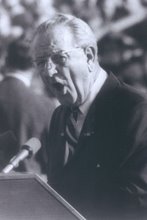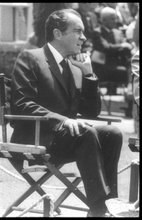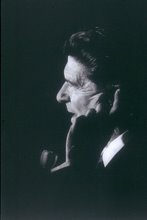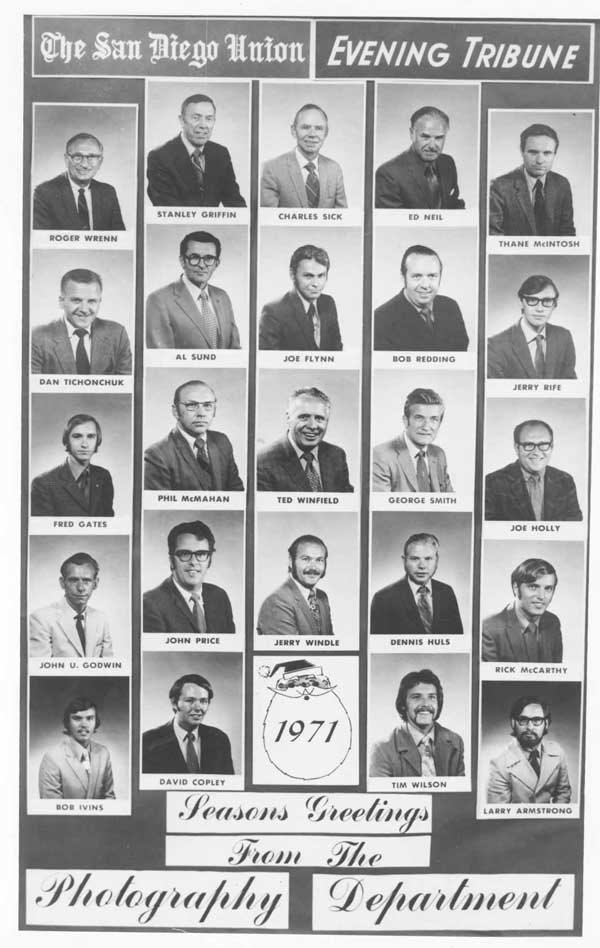
Good evening, 919 Gang, and we have distressing news tonight
CHERYL CLARK writes:
I just heard from Karin Winner that Al JaCoby died early this morning, apparently in his sleep.
BOB WITTY writes:
Pat JaCoby called me this morning to tell me that Al had died last night in his sleep. I was to have lunch with him and Neil Morgan and another friend, architect Bob Mosher, today at the MOCA cafe in La Jolla. Pat said we should go ahead and leave an empty seat for Al, which we did.
Al was an outstanding journalist, a brilliant curmudgeon ( and much loved for a curmudgeon), and could discuss any subject. His birthday was Sunday.
JR: Bob Witty also said the U-T will do an obit on him for Tuesday. And I presume that will have details on services. I am certain many of you will have memories of Al to share with us. For my contribution, I will reprint this story which Al wrote for the first edition of the merged Union and Tribune Feb. 2, 1992. And thanks to Dick Harrington who retrieved this for me maybe two years ago.
AL JaCOBY wrote:
Oh, the things we did! The places we went! The people we knew! The fun we had!
Being a newspaper man -- or woman -- in the years since World War II in San Diego meant total dedication to proving the old saw that reporters met the most interesting people -- and most of them were in the newspaper business.
We worked hard. We played hard. We drank hard.
Oh, the changes!
The other evening, one of The San Diego Union's brightest and most talented young reporters was in the men's bathroom, changing from his daytime suit into running togs and shoes, and then he was off to the gym. The gym bag is a regular sight these days in the newsroom. The noontime racquetball games are discussion topics at midafternoon news planning meetings.
Other staffers routinely bicycle to the Union-Tribune's Mission Valley office, and there are regular notices on bulletin boards of weekend multi-miled biking trips.
Oh, the difference! For the better, of course.
But, oh the fun we had -- or thought we were having!
Several high-level editors, who these days lead exemplary and predictable lives, had their salad days. One, for example, often was seen late at night playing ragtime piano in a run-down sports bar. Another editor, now dignified in London-cut suits, was one of a group of young reporters who would close the bars in San Diego and then roar down old Highway 101 to Tijuana, where the bars never seemed to close.
In truth, we were mostly newspapermen because the business, which is still far too much a bastion of white males, was truly masculine then. I can remember, back in the early 1950s, only one woman reporter, a sweet spinster lady. She knew she had to drink and smoke as well as any of us to prove her worth.
There were women in what then was called The Society Department, of course, but they didn't count because they wrote what we called "soft" news, and we were hard-bitten newsmen.
The best-known newspaper bar was the most convenient -- the Press Room right across Second Avenue from the old green-painted moderne U-T building.
The Press Room claimed to be the oldest operating saloon in San Diego and had dozens of framed photographs of news events, news people and news pages on its walls.
In the third-floor newsroom, one could casually say, "I'm going to run down to the Composing Room" (which was on the second floor), then duck down the back stairs, walk through the Composing Room and down to the ground floor and dash across Second Avenue. Press Room bartenders seemed to know when speed was essential.
A few quick gulps, and it was back across the street, up the stairs through the Composing Room and back into the newsroom, with no one the wiser, or so we assumed.
It was an unwritten, unspoken law, of course, that this wasn't done on deadline.
The Press Room, of blessed memory, is Dobson's now, but it's not the same.
We wonder, ruminating about the Good Old Days, what happened to the photographs.
In the 1960s, the favorite night-side news bar was the old Sheng Haw Low, on the second floor of a building between Broadway and C Street, across from the U.S. Grant Hotel. Sheng Haw Low was owned by a tall, amiable Chinese named Tommy Sheng. He had made his basic Cantonese restaurant into a hangout for news types, cops, lawyers and the occasional judge by a simple expedient -- cheap food and ample drinks.
Like Rick's in Casablanca, everybody went to the Sheng Haw Low. Even the ladies of the Society Department stopped by.
Tommy Sheng's greatest asset was his short, twinkly eyed bartender, Robert C. (Bobby) Tom, who knew us all, knew our drink preferences, knew our work schedules, and, above all, knew how to pour a drink.
For eternally short-funded news types, Sheng Haw Low was a godsend. It was a Chinese restaurant but the Luncheon Steak -- a nice piece of meat, fried rice, and a salad -- costing $1.25 was the odds-on favorite, even at night.
Tommy Sheng, whose English never equalled his hospitality (you could hold a five-minute conversation with him and never understand a word), was free-handed with the gotlet chicken and other appetizers.
Many a news story was developed from the lawyers, cops and judges who frequented the place.
The Grant itself was the center of the world then: Conventions, luncheon clubs, cocktail parties -- all were centered in the weathered old building between Third and Fourth avenues on Broadway. The Grant Basement was a hodgepodge of meeting rooms, large and small. The Grant's luncheon club menu of chicken and peas was a dependable standard. The Grant's rumaki, a piece of chicken liver wrapped in greasy bacon, was offered in great trays at any cocktail party. It was favored over the dollops of red caviar plopped on tiny rounds of white bread, also offered.
Out-of-town guests were always taken to El Cortez Hotel, long since closed, which in later years had a glass elevator running from the lobby to two top floors, with their glorious views of downtown and the harbor. This was pre-high rise, and the El Cortez, on its hillside locations, was our best example of skyscrapering.
The men and women of The Union who practiced newspapering were fabled, even then.
Salaries were low and everyone attempted freelance writing to supplement income. One reporter was famous for his years of submitting articles, which were always rejected, to national magazines. He finally made it to one of the magazines -- with an article about the many articles he'd had rejected.
One reporter is still recalled by those who were there for the night he hurled a hamburger (it didn't have the tomatoes he'd ordered) at a nearby wall, where it stuck. Months later, when we moved out of the building, the stain was still there.
It was rumored that this same reporter, in a fit of anger, had tossed a typewriter out of a third-floor newsroom window but this was never confirmed. Our ancient Underwood manual typewriters were too heavy for throwing.
Still another reporter always carried around the guilt of his misdeeds, probably because he was the son and grandson of Methodist ministers. "I've quit drinking," he told me one afternoon. "I can't take the hangovers in the morning." Why didn't he just sleep later, I asked, with what seemed like good logic.
"Can't," he answered. "Got to be up early to jog." He'd broken from his Methodist upbringing but he still knew he had to be punished for his transgressions.
Some of the copyreaders, the skilled men (and now, women) who regularly rescue reporters' copy in the editing process, were especially odd. One, who had worked at the paper for many years, resented any newcomer who might, in error, sit in his chair on the horseshoe-shaped copy desk. He wouldn't politely ask the newcomer to move; polite wasn't in his vocabulary. Instead, he'd sit and glare at the miscreant, who soon became aware of the angry stare in his direction.
Then there was the movie critic, a short man, hardly five feet tall, with rather short legs. He wandered from the Grant Grill one night onto Third Avenue, decided he was tired, and sat down on the curb, which was especially high at this point. His short legs just made the pavement and as he sat there, he hailed a passing "taxicab."
Unfortunately, this cab was a black and white police squad car.
Photographers were famous. One risked his job on a social event photo shoot when he snarled at a bossy admiral that "you sail your ships, sonny, and I'll take the pictures." Another, later a picture editor, was immortalized in a Press Room Bar photo dancing on the stage of the Hollywood Burlesque Theater with Texas Bobby Roberts, a home-grown stripper.
The photo lab, too, had its special moods. On Friday night, those in the know knew that the developer trays in one tiny lab would be filled with gin.
Our transgressions seemed major at the time; now they seem minor in memory.
In between, we worked hard and produced a newspaper every morning.
The U-T building itself was a collection of buildings, additions, remodels and partitions, just off Broadway with entrances at 919 Second Ave. and 940 Third Ave. Talk of a New Building went on forever. The new building became a reality in 1973 with the U-T's present modern complex in Mission Valley, a dream of James S. Copley's which, ironically, was occupied on the night he died of cancer.
The new building in Mission Valley was modern, spacious and clean. Naturally, we missed the old building.
The nearest bar-restaurant was just far enough away to prevent quick drink breaks. Another motel, across the freeway, tried to attract the newscomers with a bar named the Pen and Pun and decorated with Old New Yorker cartoons, but it never caught on. The nearby Holiday Inn housed the San Diego Press Club for a while but, at night, was quiet as a post-deadline newsroom.
What we didn't realize was that the move to Mission Valley came just as the city's newspapers were maturing and its news types were growing up, too.
Homes in the suburbs and families and the healthy life took over just about the same time the U-T got a building with air conditioning that worked.
Wine spritzers became the greatest sin at noon-time drinking sessions; the chef's salad and put the dressing on the side replaced the hot beef sandwich with extra gravy. A way of life was replaced by a Way of Life.
On that final night -- Saturday, Oct. 6, 1973 -- in the old building downtown, on the night Jim Copley died, our lives were to change forever, though we didn't know it.
About 3 a.m., after the last edition was in, after the bars had closed, after virtually everyone had gone home, I stood alone amid the detritus of most of my working life, in the dirty old Union newsroom with its sea of scrap paper on the black linoleum-tile floor.
There were half-empty coffee cups on the battered old desks, stacks of old newspapers, stubs of copy pencils and tattered carbon paper (why was there never any new carbon paper?) There was an ancient bulletin board with ancient work schedules and ancient jokes and ancient headlines and notices of freeloads long gone.
I was angry because there was to be change, and newspaper types, though they may claim to be far-seeing and adventuresome, hate change; I was sorrowful because a man who had been my top boss for years was dead. I was even a bit afraid because who could know the future.
And, thinking of T.S. Eliot's stricture that the world ends not with a bang but with a whimper, I picked up a slug of lead printing type.
"There has to be some sort of bang!" I yelled, though there was no one in the newsroom to hear, and I threw the slug as hard as I could at a glass-doored official-notice bulletin board on a wall 10 feet away.
And missed!
I should have known that newspapering would never be the same.
Alfred JaCoby, who has worked for The San Diego Union since 1953, retired yesterday. He has been commissioned to write a history of The Union.
--------------------------------------------













